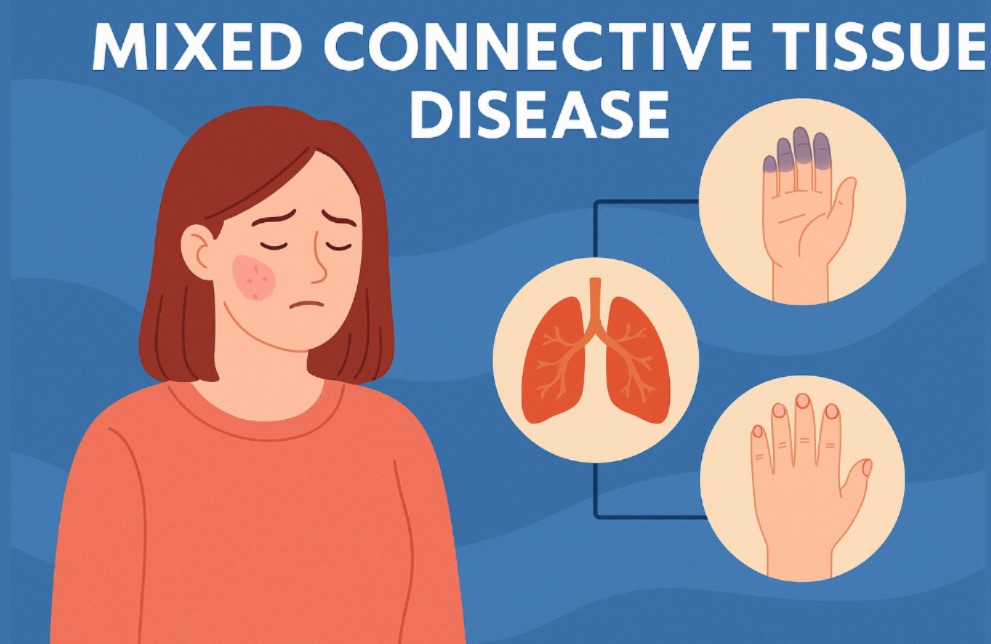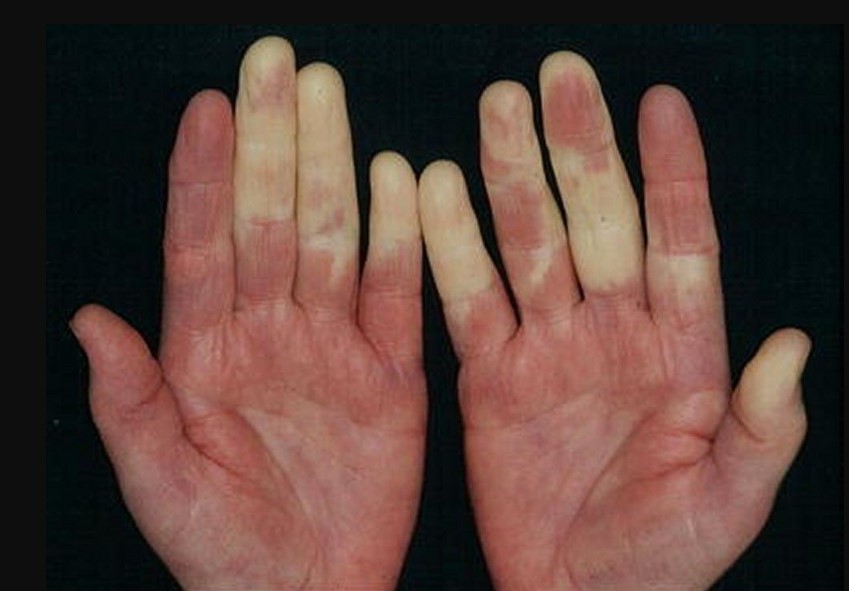Health
Mixed Connective Tissue Disease: Causes, Symptoms, and Treatment

Mixed connective tissue disease is a rare autoimmune condition that shows characteristics of several other connective tissue disorders. It shares features of systemic lupus erythematosus, scleroderma, and polymyositis. Some patients may also show signs of rheumatoid arthritis. Because it overlaps with multiple disorders, it can be challenging to diagnose. Understanding its causes, symptoms, and treatment options can help people manage it better and work with their doctors to reduce complications. This article explains the key facts about this condition in a clear and organized way.
What is Mixed Connective Tissue Disease

Mixed connective tissue disease is an autoimmune disorder. In autoimmune diseases, the immune system mistakenly attacks the body’s own tissues. In this condition, the immune system mainly targets connective tissues, which support and connect various parts of the body such as skin, muscles, joints, and internal organs. It is considered an overlap disease because it combines clinical signs of several autoimmune conditions. The disease can affect many systems of the body, including the skin, muscles, joints, lungs, heart, kidneys, and gastrointestinal tract. Because of this wide range of possible symptoms, the disease can vary greatly from person to person.
Who Gets Mixed Connective Tissue Disease
Mixed connective tissue disease is uncommon. It can affect people of any age, but it is most often diagnosed in women between the ages of 15 and 40. The exact reason why some people develop this disease is not known. However, researchers believe that both genetic and environmental factors play a role. People with a family history of autoimmune disorders may have a higher risk. Environmental triggers such as certain infections, stress, or exposure to harmful chemicals may also contribute. It is important to note that having risk factors does not mean someone will definitely develop the disease, but it may increase the chances.
Possible Causes and Risk Factors
The exact cause of mixed connective tissue disease is still unknown. However, several factors are believed to contribute to its development. These include:
- Genetics: Certain genetic markers are found more often in people with the disease. This suggests that inherited genes may make some people more likely to develop it.
- Immune system malfunction: The immune system attacks healthy connective tissues, which may be caused by abnormal immune regulation.
- Hormones: The disease is more common in women, suggesting that hormones such as estrogen might influence risk.
- Environmental triggers: Viral or bacterial infections and exposure to toxins might act as triggers in people who are genetically predisposed.
These factors may interact, but no single cause has been confirmed. Research is ongoing to understand why the immune system becomes overactive in this condition.
Common Symptoms
Mixed connective tissue disease can affect multiple parts of the body. Symptoms can be mild in some people and more severe in others. They may also change over time. Common early symptoms include:
- Fatigue
- Fever
- Swollen fingers or hands
- Joint pain and stiffness
- Muscle weakness
As the disease progresses, additional symptoms may appear, depending on which organs or tissues are affected. These can include:
- Skin rashes or thickening of the skin
- Difficulty swallowing or heartburn
- Shortness of breath
- Chest pain
- Numbness or color changes in fingers when exposed to cold (Raynaud’s phenomenon)
- Swelling of the hands and feet
- Mouth ulcers
- Hair loss
Because these symptoms overlap with other autoimmune disorders, doctors often need to run several tests to confirm the diagnosis.
Organ Systems That May Be Affected
Mixed connective tissue disease can involve various organs and body systems. Some of the most commonly affected include:
- Joints and muscles: Many patients experience joint pain, swelling, and stiffness, especially in the hands and wrists. Muscle inflammation can cause weakness, particularly in the shoulders and hips.
- Skin: Skin involvement can include rashes, thickening, or tightness similar to scleroderma.
- Lungs: Lung problems can include inflammation, scarring (pulmonary fibrosis), or high blood pressure in the lungs (pulmonary hypertension).
- Heart: The disease may cause inflammation of the heart muscle (myocarditis), the lining around the heart (pericarditis), or lead to heart rhythm problems.
- Kidneys: Although less common, kidney inflammation can occur in some cases.
- Digestive system: Problems such as difficulty swallowing, acid reflux, or decreased bowel movement may develop.
How it is Diagnosed
Diagnosing mixed connective tissue disease can be challenging because of its overlapping symptoms. Doctors usually start with a detailed medical history and physical examination. They look for a combination of clinical signs from different connective tissue disorders. Several tests can help support the diagnosis:
- Blood tests: These are essential. Most people with the disease have high levels of anti-U1 ribonucleoprotein (RNP) antibodies. Blood tests can also check for inflammation markers and other autoantibodies.
- Imaging tests: X-rays, CT scans, or MRIs may be used to check for joint, lung, or heart involvement.
- Biopsies: In rare cases, a small tissue sample from skin or muscle may be taken to look for signs of inflammation.
A diagnosis is usually made when a person has symptoms from at least two connective tissue diseases along with positive anti-U1 RNP antibodies. Doctors often monitor patients over time before confirming the diagnosis because symptoms can develop gradually.
Stages and Progression
Mixed connective tissue disease does not follow a single pattern. Some people have mild symptoms that remain stable for years. Others may have flare-ups when symptoms worsen and then periods of improvement. In some cases, the disease can gradually evolve into a single autoimmune disorder such as lupus or scleroderma. Because of this, regular medical follow-up is important to track any changes and adjust treatment when needed.
Possible Complications
If not managed properly, mixed connective tissue disease can lead to complications. Some possible complications include:
- Pulmonary hypertension, which can strain the heart and lungs
- Interstitial lung disease, which can reduce breathing capacity
- Heart inflammation or rhythm disturbances
- Kidney damage or failure (rare)
- Severe joint damage and deformities
- Increased risk of infections due to immune system problems or medications
Early treatment and regular monitoring can lower the risk of these complications.
Treatment Overview
There is no cure for mixed connective tissue disease, but treatments can control symptoms, reduce inflammation, and prevent organ damage. Treatment plans are personalized based on which parts of the body are affected and how severe the disease is. They often include medications, lifestyle changes, and regular monitoring. The main goals are to reduce symptoms, maintain quality of life, and prevent long-term damage.
Commonly Used Medications
Different types of medications are used depending on the patient’s symptoms and organ involvement. Some common options include:
- Nonsteroidal anti-inflammatory drugs (NSAIDs): Help reduce pain, swelling, and inflammation in the joints and muscles.
- Corticosteroids: Often used to control inflammation quickly during flare-ups. These may be given at low doses for long-term use or at higher doses for short periods.
- Immunosuppressive drugs: Such as methotrexate or azathioprine, are used to control the overactive immune system and protect organs from damage.
- Antimalarial drugs: Like hydroxychloroquine, which can help manage joint pain, skin rashes, and fatigue.
- Vasodilators: Used to improve blood flow in patients with Raynaud’s phenomenon.
- Medications for pulmonary hypertension: If the lungs are affected, specific drugs may be used to reduce blood pressure in the lung arteries.
These treatments are often adjusted over time depending on how the disease responds.
Monitoring and Follow-Up Care
Because mixed connective tissue disease can affect multiple organs, regular monitoring is an important part of managing the condition. Doctors often schedule routine blood tests, imaging scans, and physical examinations to track changes. Monitoring helps detect organ problems early so that treatment can be adjusted quickly. Some common follow-up steps include:
- Regular blood tests to check inflammation levels, kidney function, and antibody levels
- Lung function tests to detect early signs of lung damage
- Echocardiograms to monitor heart health and screen for pulmonary hypertension
- Bone density scans if corticosteroids are used long-term
- Eye exams if antimalarial drugs like hydroxychloroquine are prescribed
This long-term follow-up care helps reduce the risk of complications and improves treatment outcomes.
Lifestyle and Self-Care Strategies
Medical treatment is the main part of managing mixed connective tissue disease, but healthy lifestyle habits can also support overall well-being. Simple daily routines can help reduce flare-ups and make symptoms easier to handle. Useful strategies include:
- Eating a balanced diet rich in fruits, vegetables, whole grains, and lean proteins to support immune function and maintain energy
- Engaging in gentle physical activity such as walking, swimming, or stretching to maintain joint and muscle flexibility
- Getting enough rest and sleep helps the body recover and reduce fatigue
- Avoiding smoking and limiting alcohol, as these can worsen inflammation and damage organs
- Protecting hands and feet from cold to prevent Raynaud’s phenomenon attacks, such as wearing warm gloves and socks
- Managing stress through relaxation techniques like deep breathing or mindfulness
These habits cannot replace medical care, but they can improve quality of life and help keep symptoms stable.
Emotional and Mental Health Support
Living with a long-term autoimmune disease can be emotionally challenging. People may feel anxious about their health or frustrated by unpredictable symptoms. It is common to experience mood changes or depression. Seeking emotional support is an important part of overall care. Helpful options include:
- Joining patient support groups to connect with others who have similar experiences
- Speaking with a mental health professional if feelings of anxiety or depression become overwhelming
- Talking openly with family and friends about how the condition affects daily life
- Learning stress management techniques to handle emotional challenges
Good mental health care can improve resilience and make it easier to follow medical treatments and lifestyle plans.
Mixed Connective Tissue Disease in Children
Mixed connective tissue disease can also affect children, although it is less common. When it appears in children or adolescents, symptoms are similar to those seen in adults. Early diagnosis is important to prevent long-term organ damage. Pediatric rheumatologists usually manage these cases. Children with this disease need regular follow-ups, supportive physical activity, and adjustments at school if symptoms affect attendance or concentration. With proper care, many children can manage the condition well and continue normal activities.
Prognosis and Long-Term Outlook
The outlook for people with mixed connective tissue disease varies. Some individuals experience mild symptoms and live relatively normal lives with treatment. Others may have more severe organ involvement that requires ongoing medical care. Over time, the disease may stay as a mixed condition or develop into a single autoimmune disorder such as lupus, scleroderma, or rheumatoid arthritis. Factors that can affect prognosis include:
- The type and severity of organ involvement
- How well the disease responds to treatment
- How early the condition is diagnosed and treated
- Whether complications like pulmonary hypertension or kidney disease develop
Regular medical care, adherence to treatments, and healthy habits can improve outcomes and reduce the risk of serious complications.
Research and Future Treatments
Research into mixed connective tissue disease is ongoing. Scientists are studying why the immune system attacks healthy tissues and how genetic and environmental factors interact. They are also testing new medications that target specific parts of the immune system more precisely. These targeted therapies may offer better results with fewer side effects than current treatments. Clinical trials are exploring new drugs, biological therapies, and ways to predict which patients are at risk of severe complications. Continued research is essential to improve diagnosis, treatments, and long-term care for this rare disease.
Summary of Key Points
To make the information easier to review, here are the main points about mixed connective tissue disease:
- It is a rare autoimmune disorder with features of lupus, scleroderma, and polymyositis.
- The exact cause is unknown, but genetic, immune, hormonal, and environmental factors may contribute.
- It most often affects women between the ages of 15 and 40.
- Symptoms can include fatigue, joint pain, swollen fingers, Raynaud’s phenomenon, skin changes, and organ involvement.
- Diagnosis requires a combination of clinical symptoms and positive anti-U1 RNP antibodies.
- Treatment includes NSAIDs, corticosteroids, immunosuppressive drugs, and regular monitoring.
- Lifestyle habits, emotional support, and self-care play an important role in managing the disease.
- Prognosis varies, but early treatment and consistent follow-up can improve outcomes.
Questions to Ask Your Doctor
People who are newly diagnosed or suspect they might have mixed connective tissue disease can benefit from preparing questions for their doctor. Examples include:
- What symptoms should I watch for as signs of disease progression?
- Which organs are currently affected, and how will you monitor them?
- What treatment plan do you recommend and what side effects might occur?
- How often should I schedule follow-up visits and tests?
- Are there any vaccines or preventive measures I should take?
- What lifestyle changes could help reduce flare-ups or protect my health?
Asking these questions can help patients better understand their condition and take an active role in their care.
When to Seek Immediate Medical Help
While many symptoms can be managed through regular care, certain signs need urgent medical attention. Patients should seek medical care immediately if they experience:
- Sudden shortness of breath or chest pain
- Severe swelling in the legs or feet
- High fever with confusion or weakness
- Sudden loss of muscle strength or difficulty speaking
- Signs of kidney problems such as very little urine, blood in the urine, or severe swelling
These could be signs of serious complications that require immediate treatment.
Conclusion
Mixed connective tissue disease is a complex autoimmune disorder that involves multiple organs and systems in the body. Although it is rare and can be challenging to diagnose, effective treatments are available to manage symptoms and prevent complications. Early diagnosis, regular monitoring, and a personalized treatment plan are essential. Medications help control inflammation, while lifestyle habits and emotional support can improve quality of life. Ongoing research offers hope for better treatments in the future. With proper care, many people with this disease are able to manage their condition and maintain daily activities. Understanding its causes, symptoms, and treatment options is the first step toward living well with mixed connective tissue disease.
-

 Social Media2 months ago
Social Media2 months agoWhat the “67” TikTok Meme Really Means
-

 Tech2 months ago
Tech2 months agoWhat To Do When Your Business Faces Network Vulnerabilities
-

 Self Improvement2 months ago
Self Improvement2 months agoUsing BCBS Rehab to Access Quality Addiction Care
-

 Games2 months ago
Games2 months agoPusoy Strategies for Play That Also Work in Pusoy Dos in English






